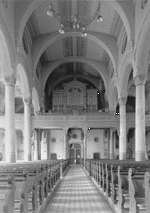Modifications of the EF Walcker Organ during the past 150 years
1900
Renovation of the bellows by Weigle Company and additional electrical bellows. The mechanical bellows still could be used. The electrical fan motor and bellow equipment is on the same level like the organ.
1922
First tonal interventions. The concert pitch has been lifted to 442 Hz and some Romantic stops have been exchanged e.g. like the Rohrfloete 4’ and Quinte 2 2/3’ against a Aeoline 8’ and Vox coelestis. To keep the renovation cost low Weigle suggested to replace the existing and expensive large pipes made of tin by cheaper galvanized pipes. (The pipes have been sold to Weigle who used them in other organs). This was the case for the large tin-pipes (C-F) of the stops Voila di Gamba, Salicional, Octav 4’ and Principal 16’(c1-f1).
1960
 During the renovation of the church in 1960 many changes have been made. The front side of the organ in Romanesque style with its seven round arches has been completely destroyed. The organ has been reinstalled without a back panel directly against the stone wall of the bell tower. This leads to problems with falling cold air during winter time when the heating is on. This cold air finds only one exit: the keyboard leading to cold fingers for the organist. In addition condensation occurs in the channels and the organ pipes as well, which leads to damages of the wooden pipes and their mistuning. During the renovation of the church in 1960 many changes have been made. The front side of the organ in Romanesque style with its seven round arches has been completely destroyed. The organ has been reinstalled without a back panel directly against the stone wall of the bell tower. This leads to problems with falling cold air during winter time when the heating is on. This cold air finds only one exit: the keyboard leading to cold fingers for the organist. In addition condensation occurs in the channels and the organ pipes as well, which leads to damages of the wooden pipes and their mistuning.
Bildnachweis Nr. 65
The size of the organ gallery has been reduced to about 50% of the original sice, leading to space problems during service when masses with orchestra and churchchoirs are performed.
Further stops have been replaced e.g. the Terzmixtur and additional 6 Romanesque stops. To achieve this, the air pressure had to be reduced, with the negative effect, that the sound volume of the organ is much too small to fill that large church.
The reinstallation of the old mechanism has been done by unskilled people which had no idea of the functionality of Walcker organs. The result is a force of about 550 g per key to press it down, when all stops are pulled out. It is therefore not possible to play brilliant Romantic organ music without getting tendovaginitis. This effect is getting worse and worse and no virtuoso is willing to play it. By the way: these high forces are typical for the big Walcker organs and are one of the reason why most of the them have been modified or destroyed and with it the great Romantic Walcker sound.
|